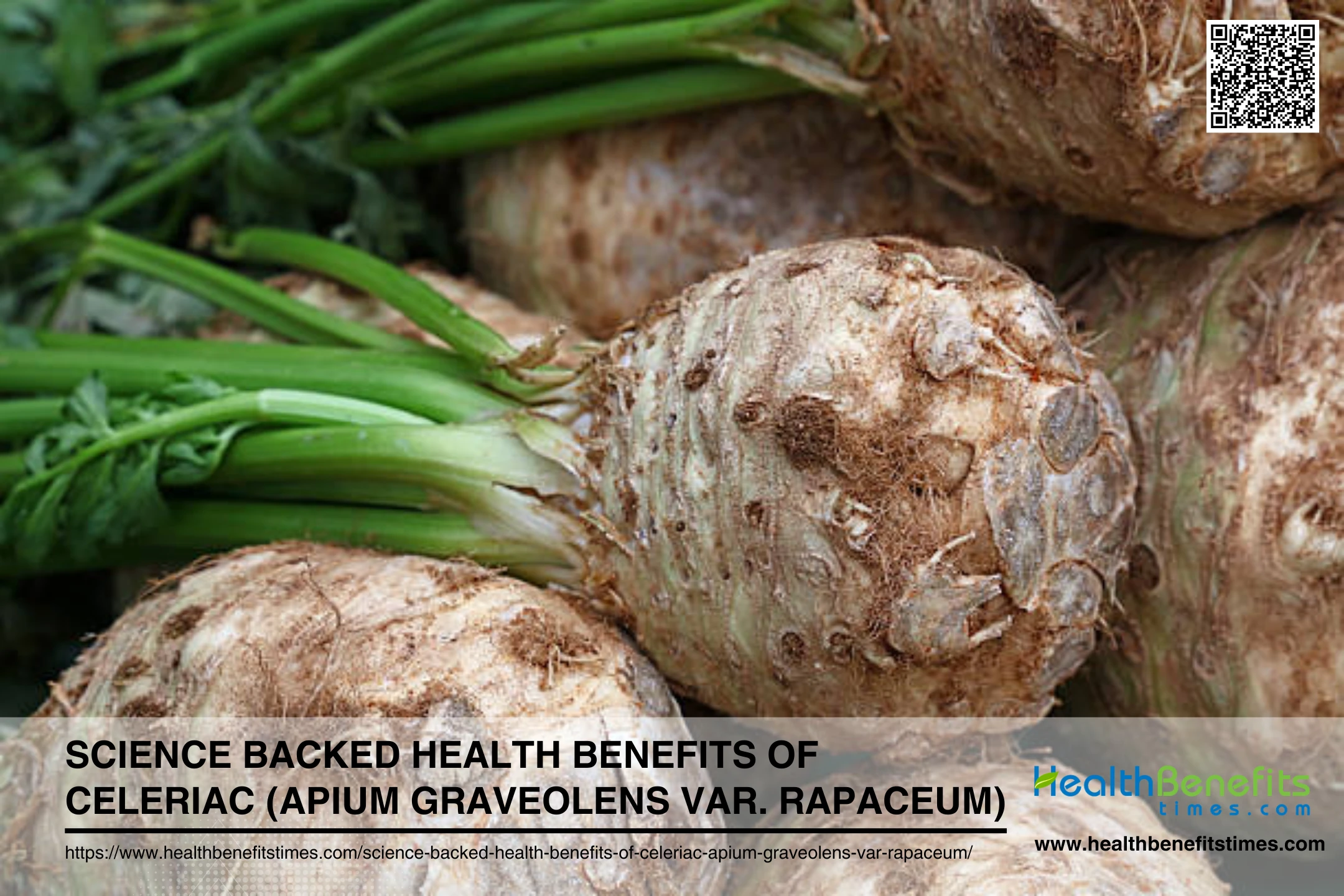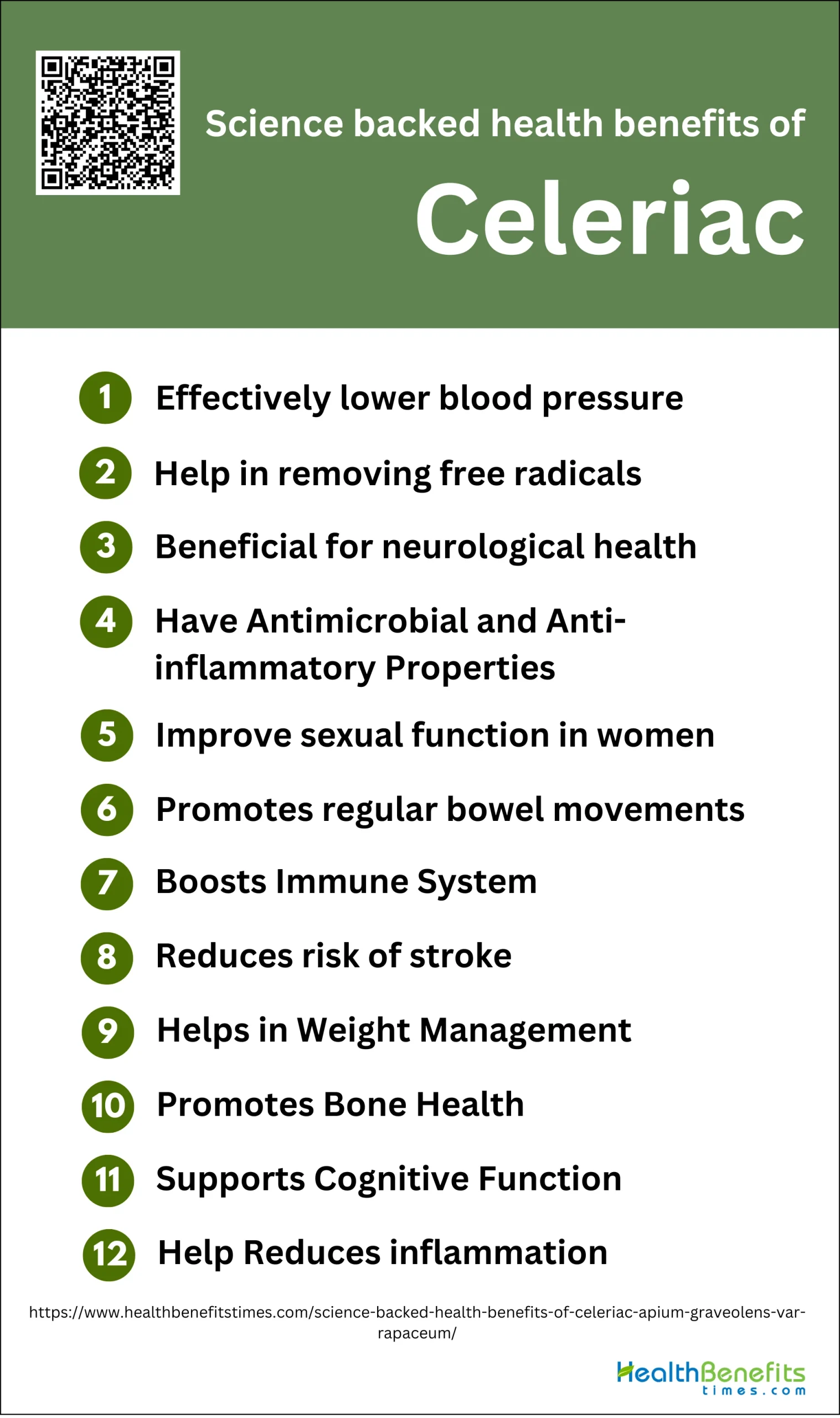- Celeriac is a nutrient-dense, low-calorie root vegetable rich in vitamins.
- Celeriac, or Apium graveolens var. rapaceum, offers numerous health benefits.
- Celeriac offers antimicrobial, anti-inflammatory, sexual health, and bowel movement benefits.
- Celeriac boosts immunity with essential vitamins and antioxidant properties.
- Celeriac promotes bone health with high vitamin K and minerals.
- Celeriac is versatile, great raw or cooked, in numerous dishes.
- Celeriac can affect blood clotting, allergies, medications, and pregnancy considerations.
 Celeriac, also known as Apium graveolens var. rapaceum, is a nutrient-dense root vegetable that offers a plethora of health benefits backed by scientific research. Often overshadowed by its more popular cousin, celery, celeriac is a powerhouse of essential vitamins and minerals, including vitamins C and K, potassium, and phosphorus. This versatile vegetable is not only low in calories but also rich in dietary fiber, making it an excellent addition to a balanced diet. Studies have shown that celeriac can bolster bone health, support heart health, and potentially reduce the risk of diabetes. Its high antioxidant content also helps combat inflammation and protect against chronic diseases. Whether consumed raw or cooked, celeriac’s unique flavor and impressive nutritional profile make it a valuable component of a health-conscious lifestyle.
Celeriac, also known as Apium graveolens var. rapaceum, is a nutrient-dense root vegetable that offers a plethora of health benefits backed by scientific research. Often overshadowed by its more popular cousin, celery, celeriac is a powerhouse of essential vitamins and minerals, including vitamins C and K, potassium, and phosphorus. This versatile vegetable is not only low in calories but also rich in dietary fiber, making it an excellent addition to a balanced diet. Studies have shown that celeriac can bolster bone health, support heart health, and potentially reduce the risk of diabetes. Its high antioxidant content also helps combat inflammation and protect against chronic diseases. Whether consumed raw or cooked, celeriac’s unique flavor and impressive nutritional profile make it a valuable component of a health-conscious lifestyle.
What is Celeriac ?
Celeriac is a distinct cultivated form of the species Apium graveolens, which also includes celery (var. dulce) and smallage (var. secalinum). Unlike its relatives, celeriac is primarily grown for its edible root, which is rich in minerals, vitamins, and amino acids. Genetic studies using RAPD and AFLP markers have shown that celeriac has a unique genetic profile compared to other celery varieties, with significant polymorphic markers distinguishing it from celery and smallage. This genetic diversity is crucial for breeding programs aimed at improving celeriac, particularly in enhancing disease resistance and broadening the genetic base by incorporating genes from wild Apium species. Additionally, celeriac contains unique aromatic compounds, such as the stereoisomers of (3a–7a)-cis-3-butylhexahydrophthalide, which contribute to its distinctive flavor profile.
Nutritional Profile of Celeriac
Celeriac, often overlooked in the produce aisle, is a nutritional powerhouse that deserves a spot on your plate. This knobby root vegetable, also known as celery root, packs a punch when it comes to essential nutrients. From its impressive vitamin content to its mineral-rich profile, celeriac offers a range of health benefits that might surprise you. In this article, we’ll dive into the nutritional profile of celeriac, exploring its key components and how they contribute to your overall well-being. Whether you’re a health enthusiast or simply curious about incorporating new vegetables into your diet, understanding the nutritional value of celeriac will give you plenty of reasons to add this versatile root to your shopping list.
Breakdown of Key Nutrients
Celeriac is a nutritional powerhouse packed with essential vitamins, minerals, and dietary fiber. This root vegetable is not only versatile in the kitchen but also offers numerous health benefits due to its rich nutrient profile.
Vitamins: K, C, B6
Celeriac is particularly rich in vitamins K, C, and B6. Vitamin K is crucial for bone health and blood clotting, with one cup of raw celeriac providing approximately 64 micrograms, which is about 80% of the daily value (DV). Vitamin C, an antioxidant, supports immune function and skin health, with a cup of celeriac offering around 12.5 milligrams, or 21% of the DV. Vitamin B6, essential for brain health and metabolism, is also present in significant amounts, contributing to 13% of the DV per cup.
Minerals: Phosphorus, Potassium, Manganese
Celeriac is a good source of several important minerals. It contains about 179 milligrams of phosphorus per cup, which is 18% of the DV, supporting bone health and energy production. Potassium, vital for heart health and blood pressure regulation, is abundant in celeriac, with 468 milligrams per cup, or 13% of the DV. Manganese, which plays a role in bone formation and antioxidant function, is also present, providing 12% of the DV per cup.
Dietary Fiber
Celeriac is high in dietary fiber, which is essential for digestive health. One cup of celeriac contains approximately 2.8 grams of fiber, aiding in digestion, preventing constipation, and promoting a healthy gut microbiome. The mix of soluble and insoluble fiber in celeriac helps maintain bowel regularity and supports overall digestive health.
Low-Calorie Content
Despite its rich nutrient profile, celeriac is low in calories, making it an excellent choice for those looking to manage their weight. One cup of raw celeriac contains only about 65.5 calories. This low-calorie content, combined with its high fiber and nutrient density, makes celeriac a valuable addition to a balanced diet, particularly for those aiming to reduce calorie intake without sacrificing nutritional value.
Science backed health benefits of Celeriac
Celeriac is a nutrient-dense root vegetable that offers a range of impressive health benefits backed by scientific research. Often overshadowed by its more popular cousin, celery, celeriac is packed with essential vitamins, minerals, and antioxidants that contribute to overall well-being. From bolstering bone health to supporting heart function and aiding in diabetes prevention, the health benefits of celeriac are numerous and well-documented. In this article, we will explore the science-backed health benefits of celeriac, shedding light on why this versatile vegetable deserves a place in your diet. Whether you’re looking to improve your bone density, manage your blood pressure, or enhance your digestive health, celeriac has something to offer. Let’s dive into the top health benefits of this remarkable root vegetable.
1. Effectively lower blood pressure
Celeriac may have potential benefits for lowering blood pressure, although more research is needed to confirm its effectiveness. The vegetable contains compounds like phthalides, which have been shown to relax artery walls and improve blood flow, potentially contributing to lower blood pressure. Additionally, celeriac is rich in potassium, a mineral known to help regulate blood pressure by counteracting the effects of sodium.
What Research Says?
- Celeriac has special substances like 3-n-butylphthalide (NBP), flavonoids, and antioxidants. These help lower high blood pressure. NBP is good at making blood vessels wider and cutting down stress on cells, which helps reduce blood pressure. Flavonoids in celeriac also help lessen swelling and make your heart healthier.
- A study looked at how celery seed extract affects people with high blood pressure. It was a well-planned trial where neither the patients nor the researchers knew who got the real treatment or a fake one. The results showed that the people who took celery extract had lower blood pressure compared to those who took a placebo, and no bad side effects were noticed. Another review of many studies also found that celery extract often lowers blood pressure. This suggests it might be a good natural way to treat high blood pressure.
- Study shows that celery extracts can lower blood pressure in animals. For example, various celery seed extracts (like hexanic, methanolic, and aqueous-ethanolic) lowered blood pressure in rats with high blood pressure but did not change it in normal rats. Another study found that a celery leaf drink did not really change cholesterol levels in rats. This suggests that celery’s main benefit might be in controlling blood pressure, not in managing fats in the blood.
- Mixing celery extract with common blood pressure medicines, such as captopril, looks hopeful. Research shows that celery extract raised the amount of captopril in the blood. This may make it better at reducing blood pressure. Also, using celery and bay leaf extracts together greatly lowered blood pressure in mice fed high-fat, salty diets.
- Celeriac is good for more than just controlling blood pressure. It helps with metabolic syndrome issues like bad cholesterol and high blood sugar because it’s full of healthy plant chemicals. Also, drinking celery root tea can act as a diuretic. It helps lower blood pressure by getting rid of extra fluid in the body.
2. Help in removing free radicals
Celeriac is a potent source of antioxidants that help combat free radicals in the body. This root vegetable contains high levels of vitamin C, flavonoids, and other phenolic compounds that act as powerful scavengers of harmful free radicals. The antioxidant activity of celeriac is primarily attributed to its polyphenol content, which includes compounds like apigenin and luteolin. These antioxidants neutralize reactive oxygen species (ROS) and other free radicals, thereby reducing oxidative stress and protecting cells from damage. Celeriac extracts exhibit significant free radical scavenging abilities, particularly against DPPH and ABTS radicals. By incorporating celeriac into your diet, you can boost your body’s natural defense against oxidative stress and potentially lower the risk of chronic diseases associated with free radical damage. The antioxidant properties of celeriac make it a valuable addition to a health-conscious diet aimed at promoting overall wellbeing and longevity.
What Research Says?
- Celeriac has many substances that fight off harmful particles in the body. These include caffeic acid, p-coumaric acid, ferulic acid, apigenin, luteolin, tannin, saponin, and kaempferol. They are powerful antioxidants. They help reduce stress on cells and protect them from damage.
- A study looked at the essential oil from celeriac leaves (CEO). It found this oil has strong antioxidant power. The oil has a lot of Phthalide and Fenipentol, which help its antioxidant effects. Researchers used a test called the DPPH assay to see how well it works. They found that CEO has an IC50 value of 30.52 ppm. This means it’s really good at stopping free radicals.
3. Beneficial for neurological health

This root vegetable contains several compounds that could support brain function and protect against neurological disorders. Celeriac is rich in antioxidants, including vitamin C and flavonoids, which help combat oxidative stress and inflammation in the brain. It also contains vitamin K, which is essential for the production of sphingolipids, a crucial component of the myelin sheath that protects nerve cells. Additionally, celeriac provides a good source of vitamin B6, which plays a role in neurotransmitter synthesis and cognitive function. Compounds found in celery and its relatives, such as luteolin and apigenin, may have neuroprotective properties and could potentially help prevent or manage conditions like Alzheimer’s disease and Parkinson’s disease.
What Research Says?
- Celeriac and its compound NBP could help treat Alzheimer’s disease. Studies show that NBP can make thinking clearer and lower amyloid-beta plaques, which are a sign of Alzheimer’s. The protective effects of NBP on the brain come from its antioxidant and anti-inflammatory actions.
4. Have Antimicrobial and Anti-inflammatory Properties
Celeriac has demonstrated promising antimicrobial and anti-inflammatory properties, according to several studies. The root vegetable contains various bioactive compounds, including flavonoids like apigenin and luteolin, as well as phenolic acids, which contribute to its medicinal effects. Celery extracts, which are closely related to celeriac, exhibit antifungal and anti-inflammatory activities. Additionally, the essential oils derived from celery and celeriac have been found to possess antibacterial properties. Celery oil demonstrated significant antimicrobial effects against various bacterial and fungal strains. The anti-inflammatory properties of celeriac are attributed to its high antioxidant content, particularly vitamin C and other plant compounds, which help combat oxidative stress and reduce inflammation throughout the body.
What Research Says?
- Studies show that celery extracts can kill germs. One study looked at how well celery fights against a tough bacteria called MRSA. They found that a small amount of celery extract could stop the growth of this bacteria. When they put the extract into a cream and used it on rats with infected wounds, it helped a lot. It killed the bacteria and made the wounds heal faster.
- A study found special substances in celery, like apigenin 7-O-mono-apiofuranoside and karafsin. These substances are strong at fighting swelling. They stopped important swelling enzymes, such as cyclooxygenase-2 and 5-lipoxygenase. They also lowered the amount of nitric oxide in immune cells. A gel made from celery extract was good at reducing swelling in rats’ paws, just like the common diclofenac gel.
5. Improve sexual function in women
Celeriac is rich in vitamins and minerals such as vitamin K, vitamin C, and B-complex vitamins, which support overall health and may indirectly enhance sexual function by improving energy levels and reducing stress.
What Research Says?
- A study tested celery seed on women’s sexual issues. It was a careful test where neither the researchers nor the participants knew who got the real treatment. They gave 80 women either 500 mg of celery seed or a fake pill three times a day for six weeks. They used a special survey called the Female Sexual Function Index (FSFI) to see the results.
- A review looked at how celery affects fertility and health. It checked 16 studies. Thirteen found that celery helps with fertility. But three studies said it might not help.
6. Promotes regular bowel movements

Celeriac can be an effective aid in promoting regular bowel movements, thanks to its high fiber content. One cup of raw celeriac provides approximately 2.8 grams of dietary fiber, which is about 11% of the daily recommended intake. This fiber acts as a natural laxative, adding bulk to the stool and helping it move through the digestive tract more easily. The combination of soluble and insoluble fiber in celeriac works to normalize bowel movements by both softening the stool and increasing its size and weight. Additionally, the fiber in celeriac acts as a prebiotic, feeding the beneficial bacteria in the gut and promoting overall digestive health. This can help prevent constipation and maintain regularity. The high water content of celeriac, which is almost 95%, also contributes to improved digestion and helps keep you regular.
What Research Says?
- Celery has properties that can calm muscle spasms and it may also help with digestion and the immune system. A study on carp fish given celery extract showed better digestive enzyme activity, like trypsin, amylase, and lipase, than fish that did not get the extract. Even though this study was on fish, it hints that celery might help human digestion too, leading to more regular bowel movements.
7. Boosts Immune System
This root vegetable is particularly high in vitamin C, which is crucial for the proper functioning of the immune system and helps protect against infections by stimulating the production of white blood cells. Additionally, celeriac contains vitamin E and various plant compounds such as polyphenols, terpenes, and phthalides, which have antioxidant properties that help reduce inflammation and combat oxidative stress, thereby supporting overall immune health. The presence of these antioxidants helps neutralize free radicals, which can damage cells and weaken the immune system.
What Research Says?
- A study looked at how adding celery extract to the diet of young common carp (Cyprinus carpio) helped their immune systems. The fish that got celery showed better immune markers. They had stronger respiratory bursts and higher levels of lysozyme and myeloperoxidase, which are key for defense against disease. Also, their blood showed more white and red cells, more hemoglobin, and a higher hematocrit value. This means they had a strong immune response.
- Celery extract might help fight germs, especially the tough kind called MRSA. A study with rats that had skin infections showed that a cream made from celery extract helped a lot. It cut down on the germs and helped the wounds heal faster by helping new skin grow and making more fibroblasts, which are healing cells. This is because celery has stuff in it like caffeic acid, p-coumaric acid, and ferulic acid. These things can stop harmful molecules called free radicals and lower stress in the body.
- Celery’s anti-inflammatory effects have been studied in mouse models. An extract made from celery leaves stopped the growth of spleen cells and lowered the release of inflammatory signals. It worked by turning down NF-κB/p65 activation, a main part of the body’s inflammation process. These results show that celery might help control the immune system by lowering inflammation, which can lead to chronic diseases.
8. Reduces risk of stroke

Potassium plays a crucial role in regulating blood pressure by counteracting the effects of sodium and relaxing blood vessel walls, which helps maintain healthy blood pressure levels. Higher potassium intake is associated with a significantly lower risk of stroke. Additionally, celeriac is rich in antioxidants like vitamin C, which help reduce inflammation and oxidative stress, further supporting cardiovascular health and reducing the likelihood of stroke.
What Research Says?
- High blood pressure is a big risk for stroke. Many studies have shown that celery can help lower blood pressure because of things in it like 3-n-butylphthalide (NBP). One study where people didn’t know if they were getting celery seed extract or a fake pill found that the extract really did lower the top and bottom numbers in blood pressure. And it was safe, with no bad side effects. Another review looked at how celery extract worked in animals. It showed that celery might help control high blood pressure by slowing the heart rate and widening blood vessels.
- Neuroprotective agents can help with brain problems caused by strokes. Celery and a special part of it, called NBP, look helpful for this. A review looked at how celery might work for brain disorders. It seems good at treating problems from strokes by affecting various parts of the body. Also, a study found that celery extract helped rats’ brains after a stroke. It made the damaged area smaller and protected the brain cells in two important areas. This was because celery has antioxidant, anti-inflammatory, and cell-protecting qualities.
- Metabolic syndrome includes problems like high blood pressure, unhealthy cholesterol levels, and high blood sugar. It raises the chance of heart diseases and stroke. Eating celery can help manage these issues and lower stroke risk. Celery has special plant chemicals that help reduce damage to our body’s cells and swelling. This helps protect the heart.
- Animal study is helpful, but we need human trials to really know if celery lowers stroke risk. A small, careful study looked at celery powder’s effects on heart health in people with type 2 diabetes. The results didn’t show big changes in heart health, but they suggested that celery might help reduce body fat and signs of oxidative stress.
9. Helps in Weight Management
Celeriac can be a valuable addition to a weight management diet due to its low calorie and high fiber content. One cup of raw celeriac contains only about 66 calories and provides 2.8 grams of dietary fiber, which helps promote satiety and reduce overall calorie intake by keeping you fuller for longer. The fiber in celeriac also aids in digestion and helps regulate blood sugar levels, which can prevent overeating and cravings. Additionally, celeriac is low in carbohydrates compared to other root vegetables, making it a suitable option for low-carb diets. Its versatility in cooking allows it to be used in various healthy recipes, from salads to soups, providing a nutritious and satisfying alternative to higher-calorie foods. By incorporating celeriac into your meals, you can enjoy a flavorful and filling vegetable that supports your weight management goals.
What Research Says?
- Study looked at how celery and its products affect weight and body shape. One study was a small, double-blind, placebo-controlled trial. It checked the effects of celery powder on people with type 2 diabetes who were overweight or obese. The study showed that eating 750 mg of celery powder every day for 12 weeks greatly lowered body fat in the group taking it compared to the control group. But, the changes in heart and metabolism factors weren’t big.
- Another study looked at how celery powder affects obesity in rats. The researchers found that when meals were replaced with 2.5% and 5% celery leaf and seed powder, the obese rats lost a lot of weight. They also saw that the rats used their food better and had smaller livers, kidneys, pancreases, hearts, and spleens compared to their body weight after eating celery powder.
10. Promotes Bone Health

Celeriac is an excellent promoter of bone health, thanks to its rich nutrient profile. This root vegetable is particularly high in vitamin K, with one cup providing approximately 80% of the daily recommended value. Vitamin K plays a crucial role in bone metabolism and has been shown to increase bone mineral density and reduce the risk of fractures. Additionally, celeriac contains other bone-supporting minerals such as calcium, phosphorus, and manganese. The combination of these nutrients contributes to proper bone mineralization and density, potentially lowering the risk of bone-related diseases like osteoporosis. Individuals with higher vitamin K intake experienced a 22% lower risk of fractures compared to those with the lowest intake.
What Research Says?
- Celeriac has lots of phenolic and antioxidant stuff that help stop free radicals and cut down on oxidative stress. A detailed review shows celeriac has things like caffeic acid, p-coumaric acid, ferulic acid, apigenin, luteolin, tannin, saponin, and kaempferol. These all make it a strong antioxidant. They are key in protecting bones from damage caused by oxidation, which can cause bone loss and diseases like osteoporosis.
11. Supports Cognitive Function
Celeriac supports cognitive function through its rich content of essential nutrients and bioactive compounds. One of the key components is vitamin K, which is crucial for the production of sphingolipids, the myelin sheath that insulates nerve fibers and ensures efficient nerve signal transmission. This is vital for maintaining cognitive health and preventing neurodegenerative diseases like Alzheimer’s. Additionally, celeriac contains antioxidants such as vitamin C and flavonoids, which help reduce oxidative stress and inflammation in the brain, further protecting cognitive function. The presence of choline in celeriac also supports brain health by contributing to the synthesis of acetylcholine, a neurotransmitter important for memory and learning. Compounds in celeriac, such as 3-n-butylphthalide (NBP), have neuroprotective effects, potentially improving cognitive performance and reducing the risk of cognitive decline.
What Research Says?
- Celeriac has compounds like 3-n-butylphthalide (NBP) that might protect nerve cells. Studies show NBP could help treat brain problems like Alzheimer’s, Parkinson’s, and stroke issues. In animal tests, NBP was safe for 18 weeks at doses of 15 mg/kg. But, some people had side effects when they took more.
- Celeriac is full of antioxidants because it has a lot of phenolic compounds. These include caffeic acid, p-coumaric acid, ferulic acid, apigenin, luteolin, tannin, saponin, and kaempferol. They work to get rid of free radicals, which cuts down on oxidative stress. This stress can lead to brain diseases. The antioxidants in celeriac help protect brain cells from harm and make brain health better.
- The celery genome shows it has genes for making flavonoids, which help it have a lot of apigenin. Apigenin is good for protecting the brain and fighting inflammation, so it’s important for how celery might help brain health.
12. Help Reduces inflammation

Celeriac helps reduce inflammation due to its rich content of antioxidants and anti-inflammatory compounds. This root vegetable is packed with vitamin C, a potent antioxidant that combats oxidative stress and inflammation by neutralizing harmful free radicals. Additionally, celeriac contains flavonoids such as apigenin and luteolin, which have been shown to possess significant anti-inflammatory properties. These compounds work by inhibiting the production of pro-inflammatory cytokines and enzymes, thereby reducing inflammation throughout the body. The high fiber content in celeriac also supports gut health, which is closely linked to inflammation regulation. By incorporating celeriac into your diet, you can leverage its anti-inflammatory benefits to help manage and prevent chronic inflammatory conditions, potentially lowering the risk of diseases such as arthritis, heart disease, and certain cancers.
What Research Says?
- Research shows that substances in celeriac, like karafsin, can block enzymes called cyclooxygenase-2 (COX-2) and 5-lipoxygenase (5-LOX). These enzymes are important in causing inflammation. For example, karafsin stopped COX-2 by as much as 70.33% and 5-LOX by up to 75.77% at some levels.
- Hydrolyzed celery extract (HCE) can lower the making and activity of inflammatory cytokines in activated splenocytes. This likely happens because it reduces the activation of NF-κB/p65, which is important in causing inflammation.
- Celeriac has antioxidants that help fight inflammation. The extract from celery leaves is rich in these antioxidants. It works well to lower oxidative stress, which can cause inflammation.
- A study mixed celery extract and binahong leaves. It found they steadily fight inflammation in rats. This supports the idea that celery helps reduce swelling.
Ways to Incorporate Celeriac into Your Diet
Celeriac is a versatile root vegetable that can be incorporated into your diet in numerous ways. Its mild, celery-like flavor and creamy texture make it an excellent addition to both raw and cooked dishes. You can grate it raw into salads, slice it thinly for crudités, or use it as a low-carb alternative to potatoes in various recipes. Celeriac can be roasted, mashed, pureed into soups, or added to stews for extra flavor and nutrition. It pairs well with other root vegetables, apples, and nuts, making it a great ingredient for autumn and winter dishes. By experimenting with different preparation methods, you can easily make celeriac a regular part of your healthy eating routine.
Raw: Salads and Slaws:
Celeriac shines in raw preparations, particularly in salads and slaws. Its crisp texture and subtle, nutty flavor make it an excellent base for refreshing dishes. A classic preparation is celeriac remoulade, where the root is julienned or grated and tossed with a mustard-mayo dressing. For a lighter option, try a celeriac and apple slaw dressed with a lemon vinaigrette. The vegetable can also be thinly sliced or spiralized to create delicate salads, often paired with ingredients like pears, walnuts, or blue cheese. Raw celeriac salads not only offer a unique taste experience but also provide a good dose of fiber, vitamins, and minerals while being low in calories.
Cooked: Soups, Stews, and Purees:
Celeriac truly shines when cooked, especially in soups, stews, and purees. Its creamy texture when cooked makes it an excellent base for velvety soups, either on its own or paired with other vegetables like potatoes or leeks. In stews, celeriac adds depth and a subtle celery flavor, complementing meats and other vegetables beautifully. As a puree, it can be a delicious low-carb alternative to mashed potatoes, often mixed with butter and cream for a rich side dish. Celeriac also works well in creamy pasta sauces, adding body and nutrition without overpowering other flavors. These cooked preparations not only highlight celeriac’s versatility but also make its nutrients more easily digestible.
Baked or Roasted: As a side dish or snack:
Baking or roasting celeriac brings out its natural sweetness and creates a delightful texture, making it an excellent side dish or snack. One popular method is to cut celeriac into wedges or cubes, toss with olive oil and herbs, and roast until golden and tender. This creates a low-carb alternative to roasted potatoes. For a more elaborate dish, try a whole roasted celeriac, which can be sliced and served as a vegetarian main course. Celeriac can also be thinly sliced and baked into chips for a healthy snack alternative. When roasted, celeriac pairs well with other root vegetables and can be seasoned with a variety of herbs and spices to suit different flavor profiles. This cooking method not only enhances the vegetable’s taste but also preserves its nutritional value.
Potential Side Effects and Considerations
While celeriac is generally safe for most people, there are some potential side effects and considerations to keep in mind. Individuals with blood clotting disorders or those taking anticoagulant medications like warfarin should be cautious due to celeriac’s high vitamin K content, which can affect blood clotting. Additionally, people with kidney problems or those on diuretics should limit their intake because of the high levels of potassium and phosphorus in celeriac. Pregnant women are also advised to avoid large quantities of celeriac as certain compounds may stimulate the womb and potentially cause contractions.
Allergic Reactions
Celeriac can cause allergic reactions in some individuals, particularly those who are also allergic to celery or other plants in the Apiaceae family, such as carrots and parsley. Symptoms of an allergic reaction can range from mild, such as itching and swelling of the mouth and throat, to severe, including anaphylaxis, which requires immediate medical attention. People with Oral Allergy Syndrome (OAS) may experience itching and swelling in the mouth and throat after consuming raw celeriac, although cooking the vegetable can often reduce these symptoms.
Symptoms to Watch For
If you suspect an allergic reaction to celeriac, watch for symptoms such as hives, swelling, difficulty breathing, and gastrointestinal issues like nausea and vomiting. Mild symptoms may include itching or tingling in the mouth and throat, while more severe reactions can lead to anaphylaxis, characterized by difficulty breathing, a drop in blood pressure, and loss of consciousness. If any of these symptoms occur, especially after consuming celeriac, seek medical attention immediately.
Interaction with Medications
Celeriac can interact with certain medications, particularly those that affect blood clotting and blood pressure. For instance, combining celeriac with anticoagulant medications can increase the risk of bleeding. Additionally, celeriac’s high potassium content can interfere with medications for kidney disease and diuretics, potentially leading to hyperkalemia. It is also advised to avoid celeriac if you are taking medications that increase sensitivity to sunlight, as it can exacerbate the risk of sunburn and skin rashes.
Consult a Healthcare Provider
Given the potential side effects and interactions with medications, it is crucial to consult a healthcare provider before incorporating celeriac into your diet, especially if you have underlying health conditions or are taking medications. A healthcare provider can offer personalized advice based on your medical history and current treatments, ensuring that celeriac can be safely included in your diet without adverse effects.
Conclusion
In conclusion, celeriac (Apium graveolens var. rapaceum) is a nutritional powerhouse that offers numerous science-backed health benefits. From effectively lowering blood pressure and promoting bone health to supporting cognitive function and aiding in weight management, this versatile root vegetable has much to offer. Its rich content of vitamins, minerals, and antioxidants contributes to its ability to boost the immune system, reduce inflammation, and combat free radicals. Celeriac’s high fiber content promotes digestive health and regular bowel movements, while its low-calorie profile makes it an excellent choice for those watching their weight. However, it’s important to be aware of potential side effects and interactions, particularly for individuals with certain health conditions or those taking specific medications. As with any significant dietary change, it’s advisable to consult with a healthcare provider before incorporating celeriac into your regular diet. By doing so, you can safely harness the many health benefits of this remarkable vegetable and enhance your overall well-being.
ADDITIONAL RESOURCES
Here are some US organizations involved in research on vegetables, along with their short descriptions and URLs:
1. USDA Agricultural Research Service (ARS)
Conducts scientific research to develop solutions to agricultural problems, including improving the production, quality, and safety of vegetables.
2. Feed the Future Innovation Lab for Horticulture (University of California, Davis)
Focuses on improving nutrition and income through research on horticultural crops, including traditional and indigenous vegetables.
3. Oregon State University, College of Agricultural Sciences
Engages in research and extension activities to improve vegetable and specialty seed crop production, focusing on sustainability and pest management.
Recommendations for books on Celeriac.
Here are some recommendations for books on research related to celeriac, including links:
1. Handbook of Herbs and Spices, Volume 3
Provides comprehensive coverage on celeriac, including its nutritional benefits, cultivation practices, and pest management.
This book covers various aspects of celery and its varieties, including celeriac, with a focus on their medicinal properties and uses.
Offers detailed information on the cultivation and benefits of various vegetables, including celeriac, with insights into scientific research.
FAQS
- What are the main nutritional benefits of celeriac?
Celeriac is low in calories but rich in fiber, vitamins K and C, potassium, phosphorus, and antioxidants. It provides important nutrients while being relatively low in carbohydrates compared to other root vegetables. - How does celeriac support digestive health?
The high fiber content in celeriac aids digestion, promotes regular bowel movements, and supports a healthy gut microbiome. Fiber helps prevent constipation and may reduce the risk of digestive disorders. - Can celeriac help with weight management?
Yes, celeriac is low in calories and high in fiber, which can help promote feelings of fullness and support weight management efforts. It can be used as a lower-calorie substitute for potatoes in many dishes. - Does celeriac have benefits for heart health?
Celeriac contains potassium, which helps regulate blood pressure. Its vitamin K content may help prevent calcium buildup in blood vessels, potentially reducing the risk of heart disease. - How does celeriac support bone health?
The vitamin K in celeriac plays a crucial role in bone metabolism and may help reduce the risk of fractures. Celeriac also contains phosphorus, another mineral important for bone health. - Are there any anti-inflammatory benefits to eating celeriac?
Yes, celeriac contains antioxidants and anti-inflammatory compounds that may help combat oxidative stress and inflammation in the body. This could potentially reduce the risk of chronic diseases. - Can celeriac help regulate blood sugar levels?
The fiber in celeriac can slow digestion and help regulate blood sugar levels. Some studies suggest that root vegetables like celeriac may help reduce the risk of type 2 diabetes. - Does celeriac have any benefits for skin health?
Celeriac’s high vitamin C content supports collagen production, which is important for skin health and may help reduce signs of aging. - How might celeriac support immune function?
The vitamin C in celeriac is crucial for a healthy immune system. Regular consumption of vitamin C-rich foods like celeriac may help support overall immune function. - Are there any potential anticancer properties in celeriac?
While more research is needed, some studies suggest that the antioxidants and other compounds in celeriac may have potential anticancer effects. However, it’s important to note that more human studies are required to confirm these benefits.


